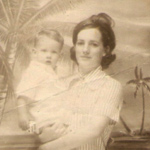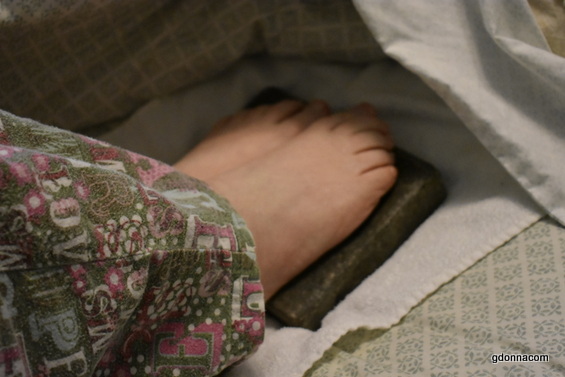
Have you ever wondered what people did to stay warm in the winter before electricity? Have you ever wondered how people stayed warm in their carriages or even cars before they had heaters? Our very cold weather had me wondering about what people did in the past.
Then I ran across an article while researching our year of 1944 and I ran across a couple of articles about how people would keep warm since fuel including heating fuel was rationed.
One article said,
With the return of chilly weather and the accompanying fuel shortage, home nurses who have old people to care for need to take precautions to see that they are comfortable. Because they are less active their circulation is likely to be sluggish and they will feel the cold more keenly than younger people.
A small electric or gas plate may be helpful before the furnace fire is started. If these are not available a hot soapstone under the feet may be all that is necessary to keep the elderly person comfortable.
So I was curious, what was a soapstone?
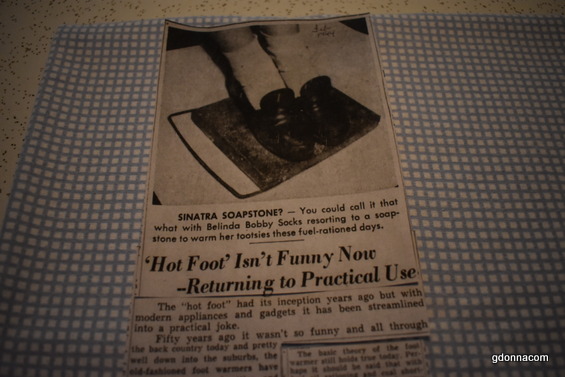
I soon found another article dating 1944.
Fifty years ago it wasn't so funny and all through the back country today and pretty well down into the suburbs, the old-fashioned foot warmers have been hauled out of attics and musty storage places this winter to be put again to practical use.
Man, 50 years ago, was not as ruddy as he would like the modern generation to believe when he pokes fun at hot water bottles and electric bed warmers. Grandpa, with his soapstone, flat iron or ol "yaller" brick, was just as much of a sissy as his grandson, only a little more practical.
Hot water bottles have a nasty habit of springing a leak shortly after midnight the coldest night in the year. It is perhaps fortunate they have gone the way of rubber bands and automobile tires. When in working order though, they make excellent foot warmers. Electric pads often have to be pampered, sometimes requiring a hurried call for the fire department.
The basic theory of the foot warmer still holds true today. Perhaps it should be said that with fuel oil rationing and coal shortages they have reclaimed some of their old importance and a hot foot again means something more than a dance-inspiring joke with matches. Was there ever a more comforting sensation than to crawl down between the sheets and find a hot brick or a flatiron or a soapstone? Was there ever a more satisfying odor than the smell of a hot newspaper, not quite scorching, which wafted up from between the sheets as they were opened to permit one to nestle into the arms of Morpheus?
In Grandpa's day the soapstone was it. Flatirons and "yaller" bricks were makeshift. The soapstone's even had flannel or quilted covers and in addition to being used as bed warmers, were a definite advantage to Grandpa and Grandma in their courting. They were used in sleighs as the forerunner of the automobile heater and have never been accused of giving off carbon monoxide.
All such hot foot applicators, of course, had to be heated to the proper temperature on the kitchen range before being wrapped and placed in bed, preferably a half hour before retiring. And all spread their comforting aura of warmth through the sheets and blankets and down into the mattress and, in due course, into the icy feet which sought them out. The "hot foot" came when the wrapping came off or an unsuspecting toe came in contact with the metal handle of the soapstone.
It is surprising today how many persons in this modern civilization are resorting to the use of the old fashioned bed warmer.
The soapstone is back.

So why a soapstone? It is my understanding that bricks or rocks can explode during heating and that soapstone is extremely dense. So I went looking for a soapstone. Here above sits a very old soapstone on our hearth.
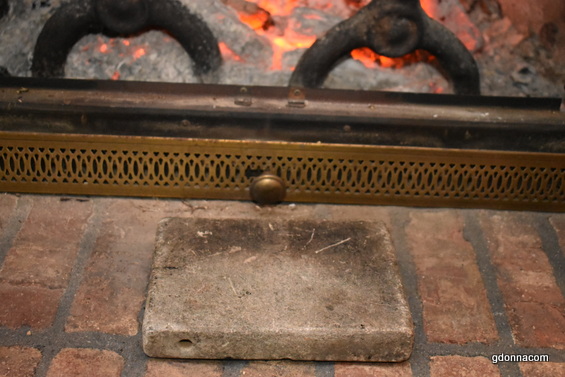
This one does not have the handle and a very long time ago people had wood burning stoves or coal stoves and people would heat these stones in their ovens of their stoves or wherever that was a warm or hot surface.
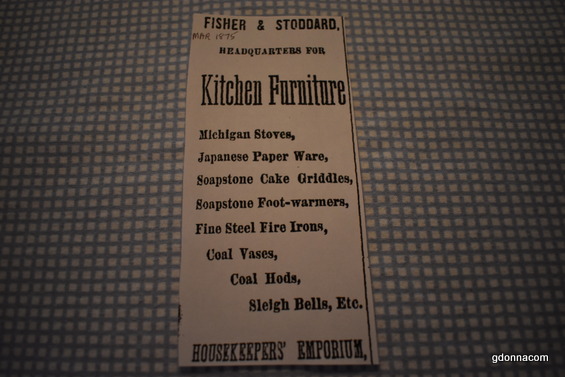
I wanted to know more... Above is an ad in the paper, dated March 1875.
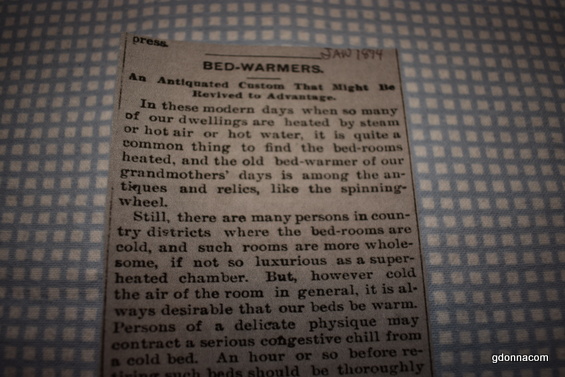
1894 An article about even though they considered these modern days with steam or hot air, hot water that it was common to find the bedrooms heated and the old bed warmers of their grandmothers days among the antiques and relics, like the spinning wheel.
But they found there were rooms that were still cold and the old soapstone very useful.
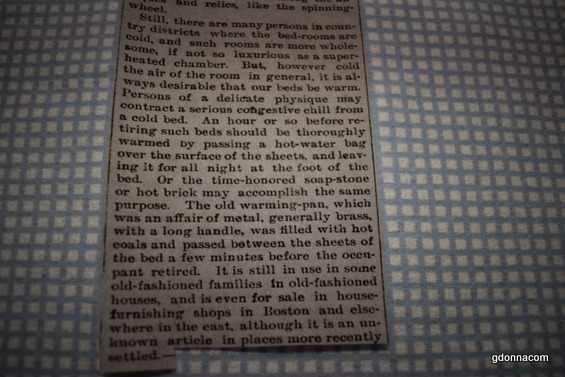
Here is the rest of that article.
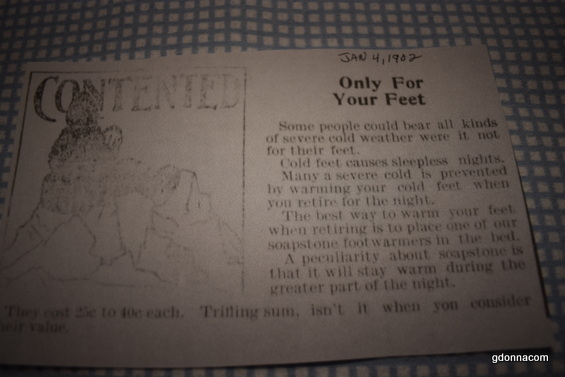
So as I followed the news it looks like during the late 1800s that the old soapstone was considered something used from the past but it then came back in favor. This article Jan 1902.
This article saying that Many a severe cold is prevented by warming your cold feet when you retire for the night.
The best way to warm your feet when retiring is to place on of our soapstone foot warmers in the bed.
A peculiarity about soapstone is that it will stay warm during the greater part of the night.

1917 the Soapstone was still common to find in the store. Remember ww1 was going on during this time, food and goods were rationed during ww1 as well as ww2.
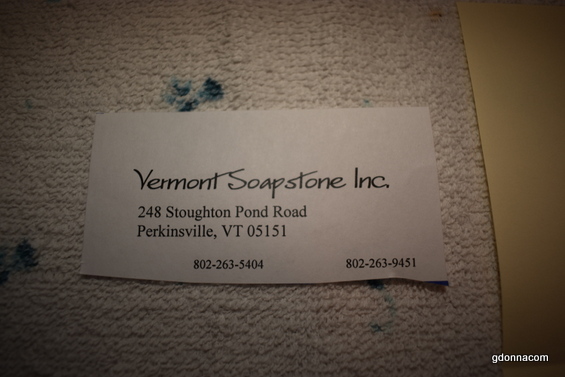
So after much thought about what would happen if there was another world war or something where times were bad how would we keep warm? We wondered if we could still buy soapstones? So I found an article dated in 1990 about a company still around called Vermont Soapstone Inc and I checked to see if they were still in business and to my surprise they are. They have been making soapstone's since the1860s. If you cannot read that number it is 802-263-5404.
I am just sharing this with you because I did not even know they existed.

So I looked them up on the internet and made the call and ordered two soapstone's and they come with the handle. They are fairly expensive $42.50 but will be something that can be passed down for generations.
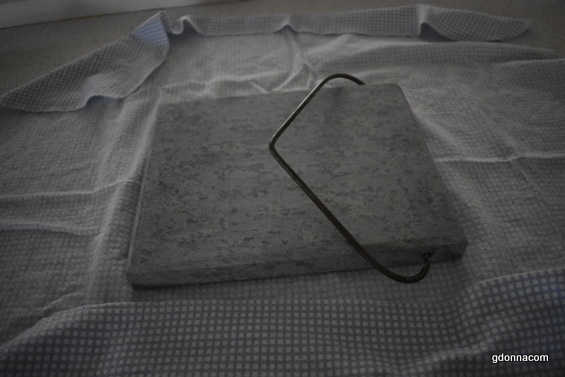
I am going to make quilted covers for them.
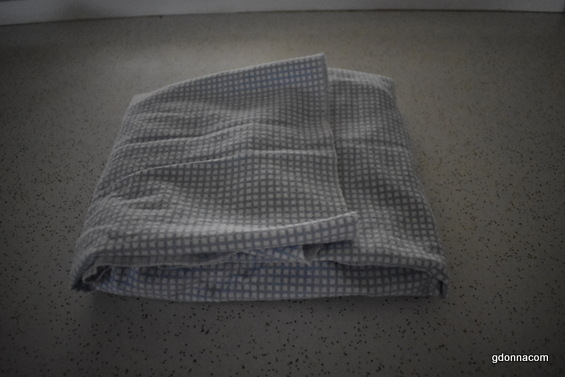
But for now a simple flannel baby blanket will do.
I did find many articles about the soapstone and how people always took their warmed soapstone and put it in the carriage to keep their feet warm. I do wonder in the movie Sense and Sensibility why Elinor and Marianne did not have a soapstone in the bed when Elinor jumped into the bed with cold feet?
I wish I had known about these stones when I was looking for a way to keep our older dog warm or the bunnies warm during cold weather instead of running heaters. Our older dog was a house dog but still needed to be kept extra warm.
I think about the uses such as a warm soapstone in a chicken house under the water container? They could be switched out when one gets cold put a new warm one in. It would certainly be an investment but they would last hundreds of years or longer. I am just happy to find more about things I did not know about living like the past and I hope you are too.
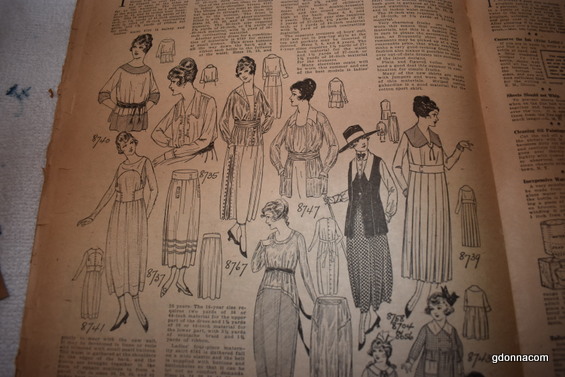
I have many more topics to discuss as we are entering the first part of our year of 1944.
I feel that it is very important to learn more about the late 1800s up to 1944 to understand the knowledge and skills these adults and especially the elders had in 1944. To find out the changes they went through during these times.
We should remember that the elders had gone through ww1, the great depression and had not even fully recovered from the depression before ww2 started. I feel it is important for us to learn about these things for when we no longer understand this we could become incapable or less prepared should a crisis occur. If nothing else it is interesting to know more about the home front and not just the wars, the great depression and what led to it but how did people live back then?
I hope you find this interesting, Grandma Donna
